History and present days

In 1934, the Greek writer Zacharias Papantoniou described the Monastery of Dionysiou as a "quite rough monastery." Despite its defensive architecture, the tower, the multi-story walls and battlements, the austere impression of the monastic structure is softened by a series of wooden balconies and windows that rise above the sea. Its strategic position protected the community from pirate raids as well as from floods caused by the nearby torrent. Notably, Dionysiou is the only monastery in Mount Athos that, since 1535, has not suffered any destruction by fire, allowing it to preserve an exceptionally rich collection of frescoes and portable icons. However, it has been through serious earthquakes (1585, 1765), a heavy snowfall (1600) and many floods (1715, 1794, 1820, 1911). Additionally, fires destroyed its surrounding forest in 1908, 1918, 1924 and 1945.
At the base of the rock, near the shore, lies the monastery’s arsanas. Its structures date back to 1618 and have recently been restored. The little house includes a pavilion and a chapel dedicated to Saint Demetrios, adorned with 17th-century frescoes and portable icons, attributed to the monastery’s iconographic workshop and the disciples of the iconographer monk Daniel. The embellishment of this chapel highlights the significance of the arsanas to the monastery, which maintained its own ship until 1930 in order to transport agricultural yields from its metochion in Orfani, near Kavala. This dependency was later expropriated to provide land for Greek refugees from Asia Minor.
Ascending from the arsanas towards the monastery, one encounters a pilgrims’ shrine, built in memory of a miracle attributed to Saint John the Baptist, who, according to tradition, appeared in that spot and stopped a pirate raid, saving the monastery from plunder. This site was also where the Patriarch Niphon received an official welcome upon being recognized by his fellow monks.
History
The monastery is dedicated to the Nativity of Saint John the Baptist. In some historical documents, it is also referred to by this name.
The monastery’s founder was Saint Dionysius, a native of Korissos in Kastoria. Initially, he lived as a monk near the Monastery of Philotheou, where his biological brother, Theodosios, used to serve as abbot. Later on, Dionysius relocated with his disciples to the foothills of the Small Mount Athos, before eventually moving closer to the sea. Twice, he experienced a vision of a luminous column rising from the present location of the monastery, which he interpreted as divine confirmation that a monastic community should be settled there.
By that time, Theodosios had become the Metropolitan of Trebizond and, by his help, Saint Dionysius sought financial support from the Emperor Alexios III Komnenos for the construction of the monastery. In response, the emperor issued an imperial chrysobull, granting the monastery extensive resources in exchange for perpetual commemoration of his name and family. 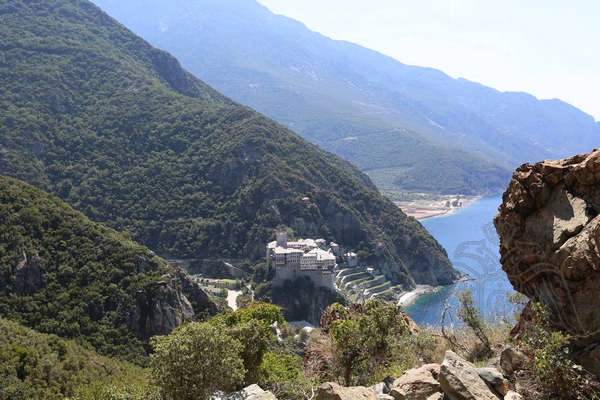 In 1389, the Patriarch Antonius IV issued a sigillion, officially recognizing the monastery as "patriarchal" and affirming its cenobitic character. After Saint Dionysius passed away (1390), his close companion, Saint Dometios (†1403 or 1405), succeeded him as abbot. The Third Typikon of Mount Athos (1394) listed 25 monasteries, placing the Monastery of Dionysiou in the 19th place.
In 1389, the Patriarch Antonius IV issued a sigillion, officially recognizing the monastery as "patriarchal" and affirming its cenobitic character. After Saint Dionysius passed away (1390), his close companion, Saint Dometios (†1403 or 1405), succeeded him as abbot. The Third Typikon of Mount Athos (1394) listed 25 monasteries, placing the Monastery of Dionysiou in the 19th place.
During the 16th century, the monastery flourished thanks to the support of the rulers of Moldavia and Wallachia. In 1520, Prince Neagoe Basarab financed the construction of the fortified tower, as well as a new aqueduct, while he also donated the skull of Saint John the Baptist along with a cross-shaped reliquary containing the relics of the Ecumenical Patriarch Saint Niphon. In 1535, a fire destroyed a great part of the monastery’s structure. Prince Petru Rareș of Moldavia (1527–1538) funded the reconstruction of the eastern wing and the katholikon. His daughter, Roxandra, and her husband, Alexandru Lăpușneanu, financed the construction of the six-story wing overlooking the sea. Roxandra and her son, Prince Bogdan, also repurchased significant monastic estates that had been confiscated by the Sultan Selim II (1568).
By the mid-17th century, economic difficulties forced the monastery to adopt a semi-idiorrhythmic system. However, the strict cenobitic rule was reestablished in 1805 through a sigillion issued by the Ecumenical Patriarch Kallinikos V.
The Monastery of Dionysiou actively supported the Greek War of Independence in Chalkidiki. When the Ottoman forces occupied Mount Athos in late 1821, many monks fled with icons and relics, seeking refuge in Poros, Zakynthos, and Skopelos. They returned in June 1830. However, there were disagreements between those who had remained and those who had fled. The returning monks introduced new customs, leading to a relaxation of the ascetic discipline. To restore the Athonite monastic character, Patriarch Konstantios I issued a sigillion in September 1830.
Monks and Serpents
At the Monastery of Dionysiou, the Elder Isaac from Eastern Thrace lived as a monk for 70 years. A simple man, he left his father's flock to become a man of God. For two years, he served as the monastery’s baker and shared his workspace with a snake about one and a half meters long. He fed it, while, in return, the snake hunted mice and slept peacefully beside him. When the Elder Isaac was assigned a new duty and another monk had to take over the bakery, the snake disappeared.
Similar stories of monks taming wild creatures are told all throughout Mount Athos. It is believed that through obedience to the word of God, these ascetics attained a state similar to the one before the fall of man, coexisting with animals as Adam once did in Paradise. This idea is visually reflected in frescoes depicting Adam naming the animals. On the other hand, at the Monastery of Pantokratoros, one of the miracles attributed to the Virgin Mary, known as Herontissa, explains how she saved Monk Spyridon from a serpent that was rolled up around his bed.
Saint Niphon
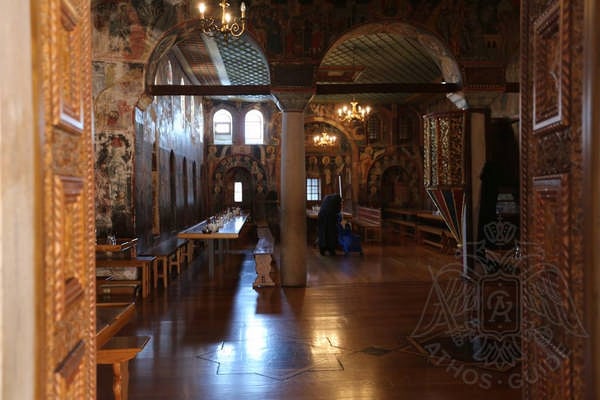 Saint Niphon was originally from Peloponnese. Before becoming a monk, he traveled through Dalmatia and Albania, preaching against the union with the Western Church, which had been signed at the Council of Florence (1439). He later became Metropolitan of Thessaloniki and twice served as Ecumenical Patriarch (1486–1489, 1497–1498).
Saint Niphon was originally from Peloponnese. Before becoming a monk, he traveled through Dalmatia and Albania, preaching against the union with the Western Church, which had been signed at the Council of Florence (1439). He later became Metropolitan of Thessaloniki and twice served as Ecumenical Patriarch (1486–1489, 1497–1498).
After resigning from the patriarchal throne, he went to Wallachia and, in his old age, returned to the monastery. He took on the humble duty of taking care of the animals. His feast day is celebrated on August 11. Saint Niphon is still deeply venerated by the Romanian people, whom he supported and guided during the hardships of the Ottoman rule and Uniate propaganda.
Among his disciples and fellow monks were the New Martyrs Saint Makarios (†1507, Thessaloniki) and Saint Joasaph (†1516, Constantinople).
Monk Eudokimos
Monk Eudokimos of Dionysiou was almost considered to be a new martyr. Twice, once in 1818 and again in 1819, he wavered in the face of martyrdom. His hesitation led to the execution of Gennadios and Joseph, who had accompanied him to offer support.
Repentant, he returned to the monastery, living in solitude for 30 years. He was the one to build terraces where olive trees still grow. Near the end of his life, he foresaw his passing away. Approaching the monastery gates, he asked for forgiveness, received the Holy Communion and, despite the abbot’s blessing to enter, chose to remain outside. Crossing his arms over his chest, he turned toward the east and peacefully surrendered his soul.
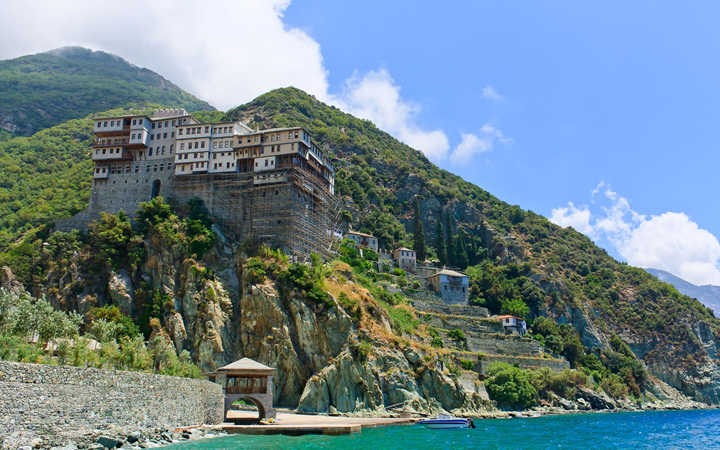
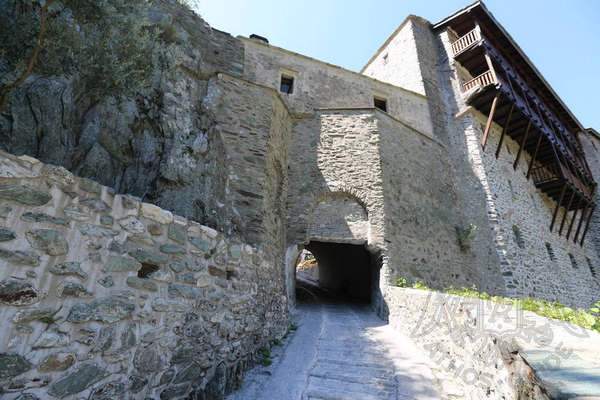

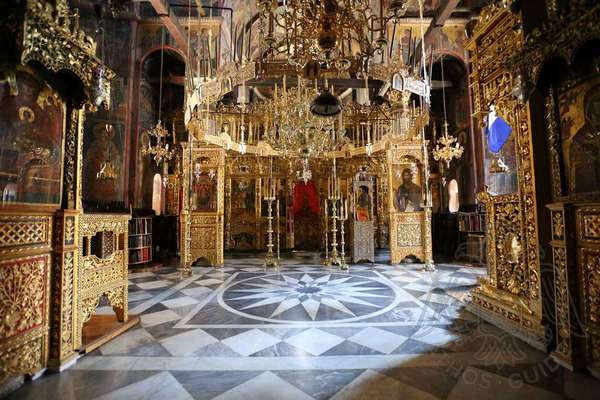
 The library contains about 10,000 books, of which 5,000 are old printed. Six early prints, dating from the second half of the 14th century, are also preserved in the monastery.
The library contains about 10,000 books, of which 5,000 are old printed. Six early prints, dating from the second half of the 14th century, are also preserved in the monastery.



